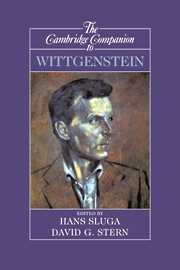Book contents
- Frontmatter
- Ludwig Wittgenstein
- 1 Wittgenstein's critique of philosophy
- 2 Pictures, logic, and the limits of sense in Wittgenstein's Tractatus
- 3 Fitting versus tracking
- 4 Philosophy as grammar
- 5 A philosophy of mathematics between two camps
- 6 Necessity and normativity
- 7 Wittgenstein, mathematics, and ethics
- 8 Notes and afterthoughts on the opening of Wittgenstein's Investigations
- 9 Mind, meaning, and practice
- 10 “Whose house is that?” Wittgenstein on the self
- 11 The question of linguistic idealism revisited
- 12 Forms of life
- 13 Certainties of a world-picture
- 14 The availability of Wittgenstein's philosophy
- Bibliography
- Index
12 - Forms of life
Mapping the rough ground
Published online by Cambridge University Press: 28 May 2006
- Frontmatter
- Ludwig Wittgenstein
- 1 Wittgenstein's critique of philosophy
- 2 Pictures, logic, and the limits of sense in Wittgenstein's Tractatus
- 3 Fitting versus tracking
- 4 Philosophy as grammar
- 5 A philosophy of mathematics between two camps
- 6 Necessity and normativity
- 7 Wittgenstein, mathematics, and ethics
- 8 Notes and afterthoughts on the opening of Wittgenstein's Investigations
- 9 Mind, meaning, and practice
- 10 “Whose house is that?” Wittgenstein on the self
- 11 The question of linguistic idealism revisited
- 12 Forms of life
- 13 Certainties of a world-picture
- 14 The availability of Wittgenstein's philosophy
- Bibliography
- Index
Summary
Recognizing what we say, in the way that is relevant in philosophizing, is like recognizing our present commitments and their implications; to one person a sense of freedom will demand an escape from them, to another it will require their more total acceptance. Is it obvious that one of these positions must, in a given case, be right?
“NEITHER SUPER-IDEALIZED GUIDANCE NOR CAPRICE”
We have got onto slippery ice where there is no friction and so in a certain sense the conditions are ideal, but also, just because of that, we are unable to walk. We want to walk: so we need friction. Back to the rough ground!
(PI, 107)Terry Eagleton, in his script for Derek Jarman's film, Wittgenstein, takes up Wittgenstein's image of the “crystalline purity of logic” in contrast to the “rough ground” of what we actually say and do. A young man, we are told, dreams of “reducing the world to pure logic,” a dream he succeeds in realizing in a world “purged of imperfection and indeterminacy, like countless acres of gleaming ice.” That world, perfect as it is, is uninhabitable: “he had forgotten about friction.” As an older man, he “came to understand that roughness and ambiguity and indeterminacy aren't imperfections - they're what make things work.” He dug up the ice to uncover the rough ground, but, “homesick for the ice, where everything was radiant and absolute,” he was unable to live on the rough ground, and he ended up “marooned between earth and ice, at home in neither.”
- Type
- Chapter
- Information
- The Cambridge Companion to Wittgenstein , pp. 383 - 410Publisher: Cambridge University PressPrint publication year: 1996
- 33
- Cited by



